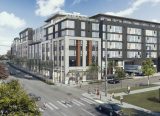Blog Post < Previous | Next >

Vulcan Real Estate and Studio 216
Our affordable housing challenge circa 2007: nothing has change but the numbers
The following opinion piece was published in the Marin IJ in July of 2007. Its reasoning is as valid now as it was then.
Arguments about affordable housing are flying back and forth - a debate pointlessly framed as a "for or against" problem. But affordable housing challenges will not be solved by sound bites and epithets. Maybe it's time to challenge our assumptions.
So following up on my discussions with columnist Dick Spotswood (IJ, June 3, "Local solutions to affordable housing, health care"), here are some points that may surprise people.
- Growth, affordable housing, diversity and economic vitality are not directly connected as assumed, but are actually separate issues, needing to be addressed separately. There's no evidence whatsoever that growth incentives produce affordable housing or social diversity - in fact they are more often inversely correlated. This is not to say that they're not related. But the impacts of those relationships are based on the way each issue is addressed, can vary widely, and are not predetermined.
- Market forces affecting affordability are regional, national and even international. They cannot be addressed effectively on a local level. Association of Bay Area Governments and state mandates applied to our small Marin cities, individually, rather than countywide, make no sense and should be contested (seeMarin County civil grand jury report, "Financing Affordable Housing, 2003).
- There is no documented evidence that inclusionary zoning, incentive bonuses and in-lieu fees are effective ways to produce affordable housing. Speaking for the American Planning Association in response to this issue, Lynn Ross stated, "I am not aware of any data of that nature. There is no definitive study of (the success of) inclusionary programs across the country."
- There is no evidence that teachers, firefighters, policemen or other city employees, as a group, are demanding "workforce" housing projects. Real demand is more varied and diverse [To clarify this further, what I meant by this when it was written was that in 2007 cities were defining "workforce" housing for teachers, firefighters, policemen, etc, as high density "projects" for only those sectors of workers. My point was we all want and deserve the same opportunities. Teachers want affordable housing no more or less than anyone else. They didn't want a "workforce projects" that were just stack and pack for teachers or firemen, etc. In addition, I should clarify that my position was not and is not categorically against high density or even high rise development, where it is appropriate. It is only that those decisions should be in the hands of local planners and their community].
- Affordable housing isn't just about new housing. It's also about rehabilitating substandard housing and broadening the definition of a housing "unit." This is particularly important in resolving our second unit and in-fill housing issues.
- All things being equal, there cannot be "affordability" without subsidy. The type of subsidy, and the methods of accumulating it, managing and leveraging it are where local factors come into play.
- Affordability and diversity are "people" problems, not "real estate" problems. They're about social justice and social value choices, not zoning and planning.
- It's more cost effective to subsidize people than real estate. Direct benefits to people produce more measurable good and free market forces to solve problems within a framework of local community values. Food stamps work and have proven so for decades.
- It's easier to raise $10 million than $10,000. In nonprofit public/private partnership endeavors, a well-planned, proposal has the best chance of attracting funding.
- Solutions are about choices, not just money. In a country that spends $500 billion on wars but about 2 percent of that directly subsidizing affordable housing each year, and $500,000 on barbecue sauce, that's irrefutable.
- Resources are always in short supply, so it's important that we use them in the most effective and efficient way possible to produce the maximum benefits.
We're constantly being told we have to choose between small-town values and affordable housing, between quality of life and diversity. Well, maybe we can't have it all, but I believe we can have a lot more than we're being told.
It may seem difficult to reconcile all the points noted above, but we can't properly address our current challenges unless we do.
And when we do, new options appear.
